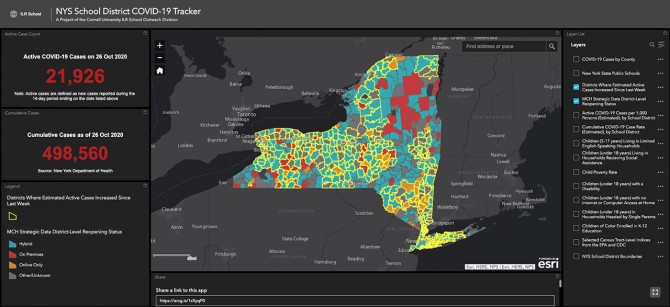Tool tracks COVID cases within NY school district boundaries
By Mary Catt
New York state officials, parents and others now have a way to check COVID-19 case numbers within the geographic boundaries of school districts and alongside other data, thanks to a new online tool.
The ILR School has launched the NYS School District COVID-19 Tracker, an interactive, web-based mapping application that combines multiple sources of data on COVID-19, demographics and related topics by school district.
The tracker allows users to display current estimates of active and cumulative COVID-19 cases per 1,000 residents living within a school district, along with socioeconomic and demographic variables, said its developer, Russell Weaver, director of research for ILR’s Buffalo Co-Lab.
The tool is designed for use by families, community groups, researchers, school districts, government officials and others to help assess COVID-19 patterns within a broad context of variables such as poverty.
“Schooling during a pandemic means that, every day, parents, employees and public officials are facing incredibly difficult decisions about how best to fulfill the educational needs of our children while protecting the health and safety of our communities,” Weaver said. “Recognizing the impossible scale of that challenge, our team is trying to do our part by centralizing relevant information from a variety of sources into one location.”
An introductory tutorial assists users in taking full advantage of the data.
“It is a great resource,” said Patty Cerio, chair of the Association of Educational Safety and Health Professionals. “We are chomping at the bit to be able to use it and to let others know that it is available.”
COVID-19 case estimates are derived from county-level data and are updated regularly to inform policy discussions and to monitor changing local conditions. To facilitate comparisons to nearby areas, case estimates are expressed as rates per 1,000 residents in each school district.
However, estimates should not be represented or interpreted as exact counts, nor should they be the only data used to assess safety or risk in individual districts, Weaver cautioned.
Socioeconomic and demographic variables available for each district include:
- population;
- school population (students and staff);
- children with disabilities;
- children living in households without computer or internet access;
- children in households receiving social assistance;
- children living in poverty;
- children living in households with limited English-language skills;
- children enrolled in K-12 education who are persons of color; and
- children living in single-parent households.
Data sources for the tracker tool include New York state’s Department of Health and Department of Education, the U.S. Census Bureau’s American Community Survey and the U.S. Homeland Infrastructure Foundation data program.
Mary Catt is the ILR School’s communications director.
Media Contact
Get Cornell news delivered right to your inbox.
Subscribe


